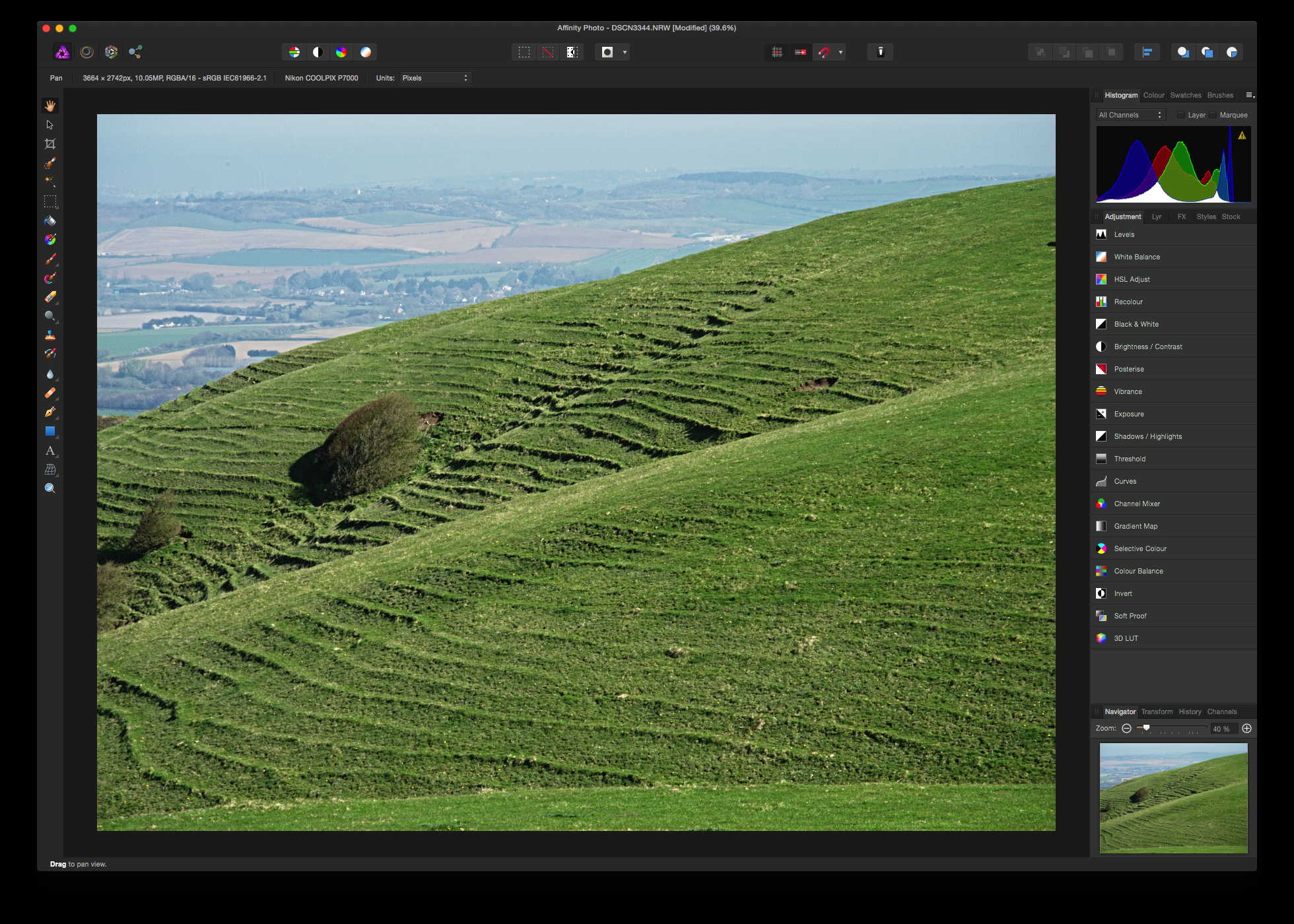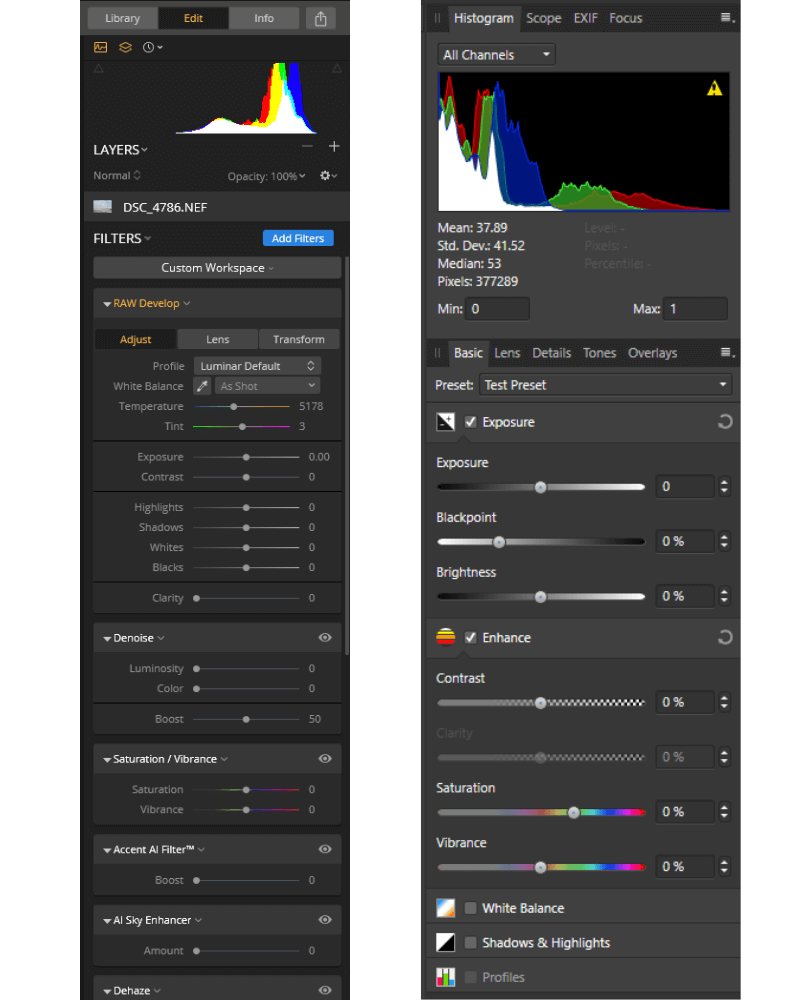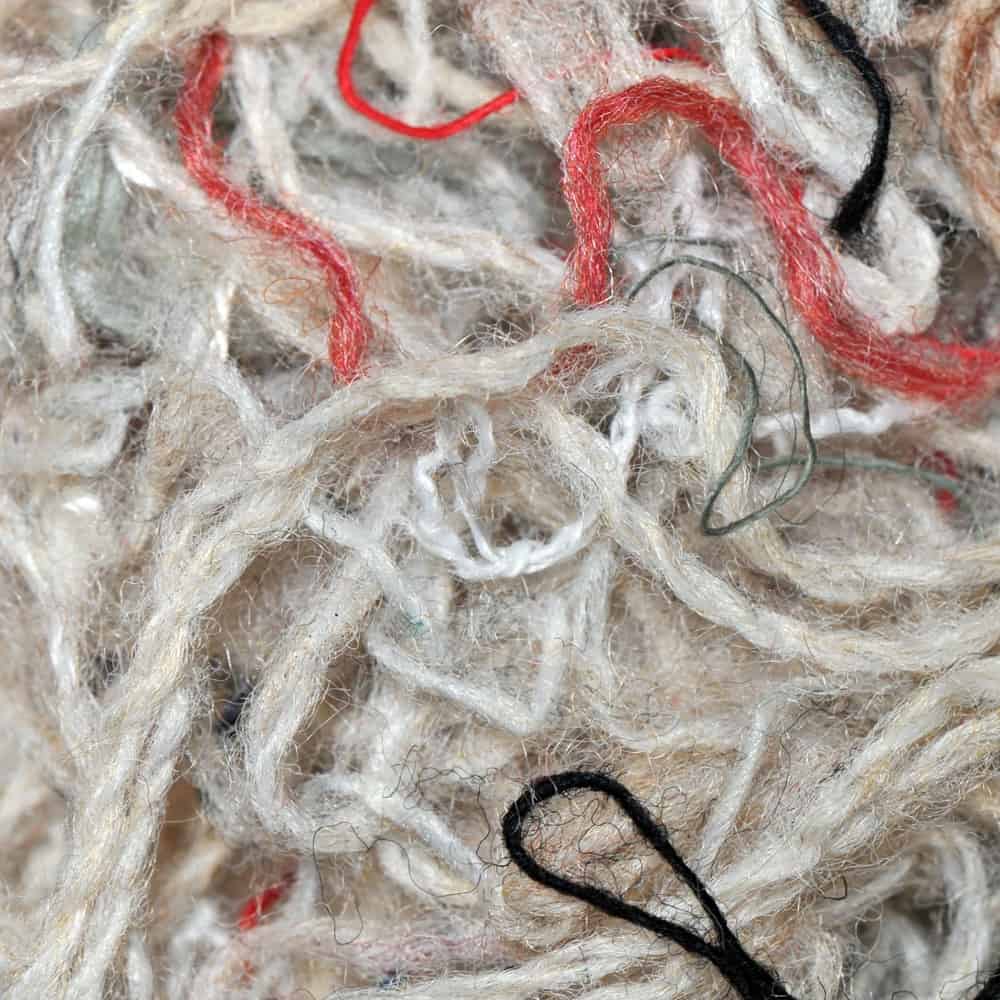The standout choice for professionals. Faster, smoother and more powerful than ever, Affinity Photo continues to push the boundaries for professional photo editing software. With a huge toolset specifically engineered for creative and photography professionals, whether you are editing and retouching images, or creating full-blown multi-layered compositions, it has all the power and performance you will ever need.
Affinity Photo has just about all of the photography-related tools that Photoshop has — such as adjustment layers, masks, color management, dynamic paint brushes, a healing brush, lens correction, and CMYK and RGB editing — as well as support for RAW and 16-bit files. However, it lacks some of Photoshop’s extra functionalities that are outside the normal photo editing realm, such as 3D editing.
In some cases, where it is different from the Photoshop workflow, Affinity Photo goes one step further. For instance, the RAW processor is part of the interface, rather than a plugin that takes you out of the workspace. In other words, you can process a RAW image in one tab and work on a JPEG or PSD in another tab at the same time. You can save any RAW edit settings as a preset and apply it to other RAW files.
Download Affinity Photo - Faster, smoother and more powerful than ever, Affinity Photo continues to push the boundaries for professional photo editing software. Dedicated RAW workspace. The issue we experienced was when working with RAW files. Obviously, these files are much larger – the photos we worked with were ranging from a minimum size of 25mb up to 30mb. When editing RAW files, Affinity Photo was slower to respond. The sliders took longer to take effect. Moreover, it took longer to export the files and render the details.
Affinity Photo’s tools and commands have a depth of functionality that will take some time to explore and master. For anyone used to Photoshop, the learning curve won’t be steep, because Affinity’s interface is as clean and logical, though some terminology is different.
Affinity Photo is a young program, which means that some key portions are still in development or have been overlooked but will probably be added in future incarnations. For instance, Serif is currently going through the extensive list of third-party Photoshop-compatible plugins to ensure they work properly in Affinity Photo. So far, it has tested the most popular ones, such as Nik and Topaz, which Serif says function fully within Affinity. If any particular plugin is important to your workflow, it would be best to check whether it’s supported before making the move to Affinity.

No matter how large your image files are, tools and commands work in real time. That’s because Affinity uses a tiled file format for resolution independent editing. To a certain extent, this is similar to Photoshop’s Smart Objects, except it doesn’t require conversion, and unlike Smart Objects that function with only some features, this resolution-independent editing is consistent throughout the program.
For those who know photo editing history, this concept will be familiar: It’s what the old program Live Picture offered. In essence, it delivers only the amount of data (or image pixels) needed to view and edit at the current zoom level. One of the major benefits of this feature is that it enables efficient memory management, so that Affinity apps don’t run out of RAM. However, when Affinity saves the edit information and applies (or renders) it to the full file, you might experience some delay, depending on the number of edits and the image size.
Affinity Photo Raw Support
Affinity Photo Editing Tutorials. If you’re new to Affinity Photo and want to learn how to use it, start here. Below you’ll find a grid of my Affinity Photo Tutorials. If you’re struggling to make sense of Affinity Photo, I’d recommend you watch my introductory video series first. Affinity Photo Tutorials. Though Affinity Photo is a serious Photoshop competitor, the RAW processing IMO is still lightyears behind what you get from Capture One. Just compare the effect of the shadow and highlight sliders in Affinity and Capture One and you immediately see the difference.
While rendering enormous files might take a bit of time, it shouldn’t interfere with your work. All operations are asynchronously designed to take full advantage of multicore processors. In other words, everything will run in parallel. For instance, while the RAW processor is developing your picture in one tab, you can paint on another in a separate tab.
This is a pretty important addition to my first impressions article.
After reading a comment thread on a photography blog it occurred to me that I had not looked particularly hard at a core feature of Affinity Photo, namely the develop (i.e. semi-non-destructive RAW-processing) phase.
I assumed Affinity Photo used Apple’s OS-level RAW-processing (which is pretty good) since just writing a good RAW importer is a major undertaking (and an ongoing commitment, as new cameras with new RAW formats are released on an almost daily basis) and concentrated my attention on its editing functionality.
(There is a downside to using Apple’s RAW processor — Apple only provides updates for new cameras for recent OS releases, so if you were using Mac OS X 10.7 (Lion) and just bought a Nikon D750 you’d be out of luck.)
Does Affinity Photo Support Raw
In the thread, one commenter suggested Affinity Photo as a cheaper alternative to Phase One (which misses the point of Phase One entirely) to which someone had responded that Affinity Photo was terrible at RAW-processing. I wanted to check if this was simply a random hater or actually true and a quick check showed it to be not only true but horribly true.
White Balance
Affinity Photo ignores the white balance metadata in the RAW file. If you toggle on the white balance option in develop mode you still need to find out the white balance settings (somehow) and type them in yourself.

Good cameras do a very good job of automatically setting white balance for scenes. Serious photographers will often manually set white balance after every lighting change on a shoot. Either way, you want your RAW-processing software to use this valuable information.
Noise Reduction
Affinity Photo’s RAW processing is terrible. It somehow manages to create both color and brightness noise even for well-exposed images shot in bright daylight — night shots at high ISO? Don’t even ask. (If you must, see the Sydney Harbor comparison, earlier.) It’s harder to say this definitively, it seems to me that it also smears detail. It’s as if whoever wrote the RAW importer in Affinity Photo doesn’t actually know how to interpolate RAW images.
Incidentally, Affinity Photo’s noise reduction filter appears to have little or no effect. An image with noise reduction maxed out using Affinity Photo is far noisier than the same image processed without noise reduction using any decent program or Apple’s RAW importer’s noise reduction.
Now, if you’re using Affinity Photo in concert with a photo management program like Lightroom, Aperture, Photos, or iPhoto — programs which do the RAW processing and simply hand over a 16-bit TIFF image — you simply won’t notice a problem with the lack of white balance support or the noise creation. But if you actually use Affinity Photo to work on RAW images (i.e. if you actually try to use its semi-non-destructive “develop” mode) you’re basically working with garbage.
I can only apologize to any photographers who might have bought Affinity Photo based on my earlier post. I mainly use would-be Photoshop replacements for editing CG images where RAW processing isn’t a factor, but my failure to carefully check its RAW processing is egregious.

If you want to use Affinity Photo for working on photographs I strongly recommend you wait until its RAW processing is fixed (or it simply adopts the RAW processing functionality Apple provides “for free”).
Remember when I discovered that Affinity Designer’s line styling tools simply didn’t work at all? That’s ridiculous. Well, a self-declared photo editing tool that doesn’t do a halfway decent job of RAW processing is just as ridiculous.
So, what to do?
Apple’s new(ish) Photos application is actually surprisingly good once you actually expose its useful features. By default it doesn’t even show a histogram, but with a few clicks you can turn it into a RAW-processing monster.

Affinity Photo Raw Processing

And, until Apple somehow breaks it, Aperture is still an excellent piece of software.
Acorn does a good job of using Apple’s RAW importer (it respects the camera’s metadata but allows you to override it). Unfortunately, the workflow is destructive (once you use the RAW importer if you want to second guess your import settings you need to start again from scratch).
Adobe still offers a discounted subscription for Photographers, covering Lightroom and Photoshop. It’s annoying to subscribe to software, but it may be the best and cheapest option right now (especially with Apple abandoning Aperture).
If noise reduction is your main concern, Lightroom, Aperture, Photoshop, and other generalist programs just don’t cut it. You either need a dedicated RAW processing program or a dedicated noise reduction program.
Finally, if you’re happy to use different programs for image management (I mainly use Finder with these days), RAW processing, and editing then you have a lot of pretty attractive options. FastRAWViewer is incredibly good for triaging RAW photos (its Focus Peaking feature is just wonderful). DxOMark and Phase One offer almost universally admired RAW-processing capabilities and exceptionally good built-in noise handling. Many serious photographers consider the effect of switching to either of these programs for RAW processing as important as using a better lens. Even the free software offered by camera makers usually does a very good job of RAW processing (it just tends to suck for anything else). If you don’t use Affinity Photo for RAW processing there’s not much wrong with it (but you don’t have a non-destructive workflow).
